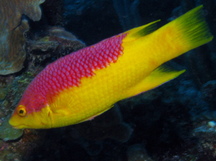Spanish hogfish (Biodiversity)
Contents
Spanish hogfish
The Spanish hogfish (scientific name: Bodianus rufus) is a member of the wrasse family (Family Labridae) that lives on coral reefs in the Western Atlantic Ocean and the Caribbean Sea.
|
Scientific Classification Kingdom: Animalia (Animals) |
Physical Description
Spanish hogfish range from 20 to 40 centimeters in length. Their bodies are chiefly yellow, with purple on the upper body. Terminal phase and initial phase individuals have similar coloration, and differ mainly in size; moreover, terminal phase individuals tend to be larger.
Distribution
This species is found in the Western Atlantic from southern Florida, USA to southern Brazil as well as in Bermuda, the Gulf of Mexico, and the Caribbean Sea.
Habitat
B. rufus typically live on coral reefs at depths ranging from one to 70 meters.
Feeding Behavior
Spanish hogfish are omnivorous carnivores that feed on invertebrates such asbrittle stars, crustaceans, mollusks, and sea urchins. Juveniles act as cleaners.
Behavior
Juveniles act as cleaners until they reach the abouteight centimeters in length at which point they switch their diet to feeding on invertebrates.
Reproduction
Spanish hogfish are protogynous hermaphrodites that change sex from females to males when females reach 15 to 18 centimeters in length. Large terminal males defend harems. Spawning occrs in the water column during the late afternoon. After the eggs hatch, the larvae enter the pelagic stage until they are large enough to settle on the reef.
Associations
Juveniles are among the most common cleaner fishes on the reef.
Threats
Studies at the Saba Reef, one of the richest fish assemblages in the Caribbean Basin, have indicated the chief threats to B. rufus and other reef fishes are overfishing and the residual impacts of the particular chemical dispersant used by the USA in the aftermath of the Deepwater Horizon oil spill; this chemical has high persistence and known toxicity to a gamut of marine fauna. Studies by Burke et al. suggest that concentrations of dispersant and other water pollutants are of particular concern in critical lagoon nurseries; these studies suggest that the toxicity of residual dispersant may be much more significant to reef fishes than the actual petroleum release of an underwater oil spill. The dispersant used in the Deepwater Horizon oil spill, Corexit 9500, is known to be much more toxic than the petroleum chemicals it is meant to disperse; moreover, the combined toxicity of Corexit 9500 and petroleum is more toxic to juvenile fish than either chemical set by itself.
Conservation Status
The spanish hogfish is not presently classified as a species at risk.
References and Further Reading
- J.S.Burke, W.J.Kenworthy and L.L.Wood. 2009. Ontogenetic patterns of concentration indicate lagoon nurseries are essential to common grunts stocks in a Puerto Rican bay. Worldwide Science.org
- Jeffrey T. Williams, Kent E. Carpenter, James L. Van Tassell, Paul Hoetjes, Wes Toller, Peter Etnoyer, Michael Smith. 2010. Biodiversity Assessment of the Fishes of Saba Bank Atoll, Netherlands Antilles. PloS One. 5(5): e10676.
- Encyclopedia of Life. Species curator: C.Michael Hogan. 2011. Bodianus rufus (Linnaeus, 1758) EOL
- P.Humann and N.Deloach (Editor), 1994. Reef Fish Identification: Florida, Caribbean, Bahamas. New World Publications, Inc. Jacksonville, FL. ISBN: 1878348078
- N.Deloach. 1999. Reef Fish Behavior, Florida, Caribbean, Bahamas. New World Publications, Inc. Jacksonville, FL. ISBN: 1878348280
- Laurier Lincoln Schramm. 2000. Surfactants: fundamentals and applications in the petroleum industry. Cambridge University Press. 621 pages

